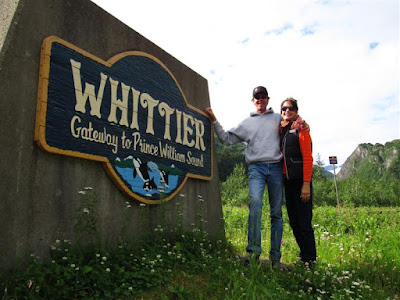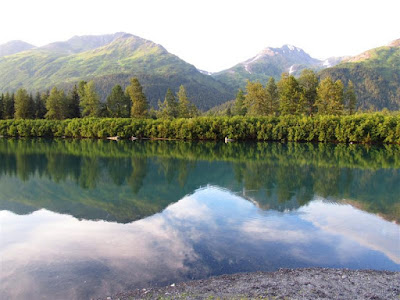We began our day by strolling to the Byron Glacier.
What a thrill to be surrounded by blue ice.
Our next stop was to visit the harbor town of Whittier. Steve grew up in Whittier, California (both named after poet John Greenleaf Whittier).
To get to Whittier, we had the opportunity to experience the weirdest transportation system we've had on this trip- the Anton Anderson Memorial Tunnel—the longest (2.5 miles) highway tunnel of its kind in North America, and the first designed for -40 Fahrenheit temperatures and 150 mph winds!
What's strange about it is the fact that the one-lane tunnel must be shared by cars and trains traveling in both directions (taking very organized turns), and it usually needs to be aired out in between trips (with jet turbine ventilation, another first). This unique design, that enables a single lane of traffic to travel directly over the railroad track, saved tens of millions of dollars over the cost of constructing a new tunnel. So weird yet cool, truly!
Glaciers were everywhere!
The area where Whittier sits today was developed during World War II. The United States Army constructed Camp Sullivan, a military facility with a port near Whittier Glacier. When a spur of the Alaska Railroad was completed to Camp Sullivan in 1943, the port became the primary debarkation point for cargo, troops, and dependents of the Alaska Command. Population in the area reached 1,200 people.

To house all those troops, and what catches everyone's eye in Whittier, is the Buckner Building, a Cold War-era military installation which once held an entire city within its walls. Started in in 1949, and completed in 1954 at a cost of $6 million, the compound was was renowned as the City Under One Roof and was used as a secret and self-contained military base. The “city” included: a small hospital, a 320-seat theater, a 4-lane bowling alley, a 6-cell jail, a church, bakery, barbershop, library, radio station, rifle range, photo lab, commissary, a huge cafeteria and kitchen, an officers’ lounge, and more than enough rooms for the military and their families to stay in at the time.
In 1960, the Whittier Army Port was closed and the building was mothballed by the U.S. Army. It has been vacant ever since, making for an interesting horizon.
Wanting to experience some of Whittier's nature and since the salmon were spawning, we headed to the river to watch the magic happen. Wow. These fish were huge and determined.
Lunch was overlooking the Harbor for Halibut Fish & Chips (again).
This area will be our home for the next several days. Let the exploring continue.
Tonight we sleep in Hope. I love the name! Hope, Alaska lies on the northern end of Kenai Peninsula, on the south shore of the Turnagain Arm of Cook Inlet. Once a mining camp for Resurrection Creek, established in 1896, it is now a cool vacation spot with a great, welcoming vibe.
First stop was at the Historical Society Museum to learn a bit about the town's past.
Then we headed to Sea View Café, Bar & Campground for Hope's future, in the form of 14 year old Miss Ava Earl... wow.
With live music and foot tapping on the patio, life seems so much sweeter in a town called Hope.
"Hope is but the dream of those who wake."
-Matthew Prior



























































Recent Comments